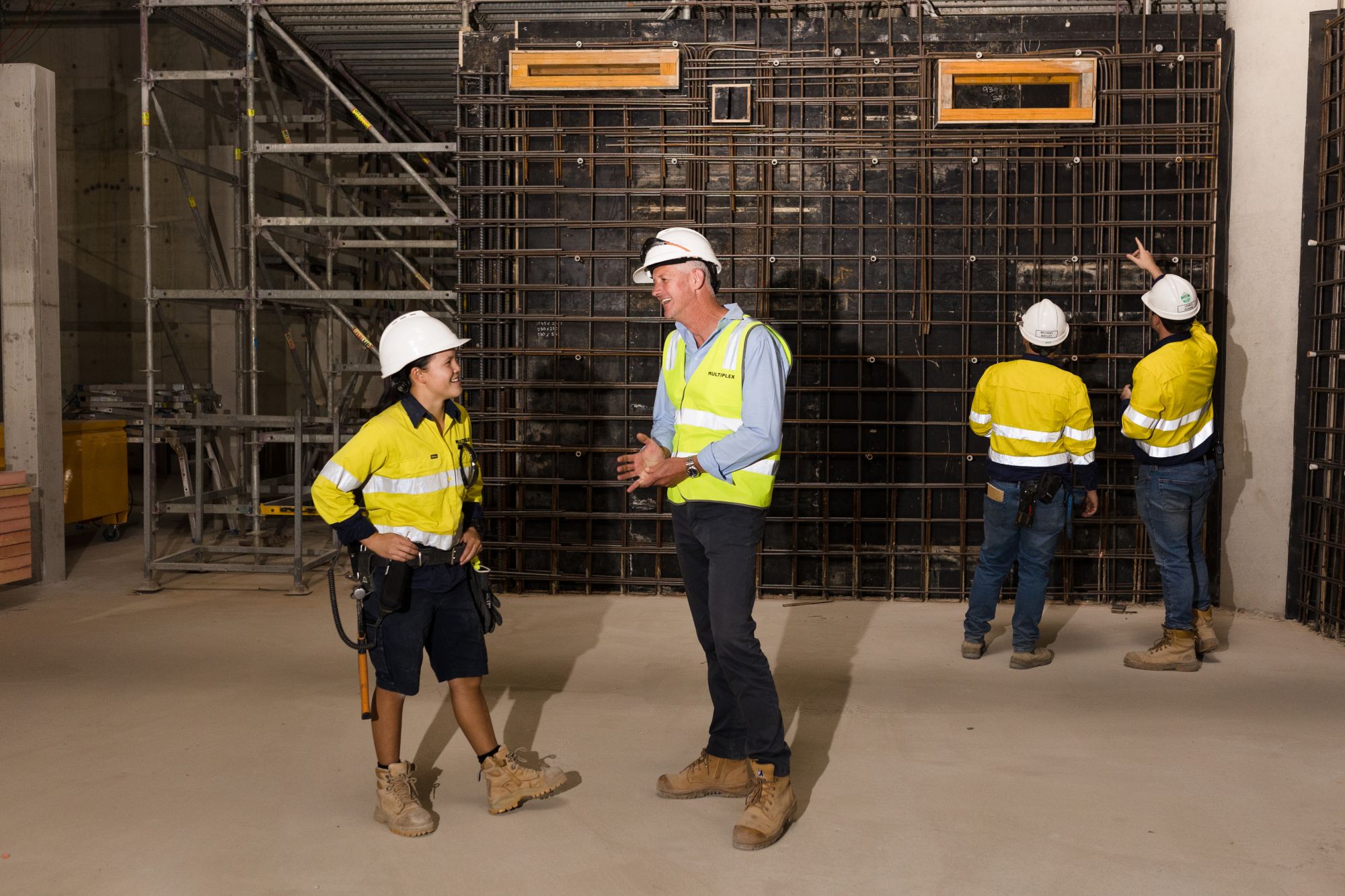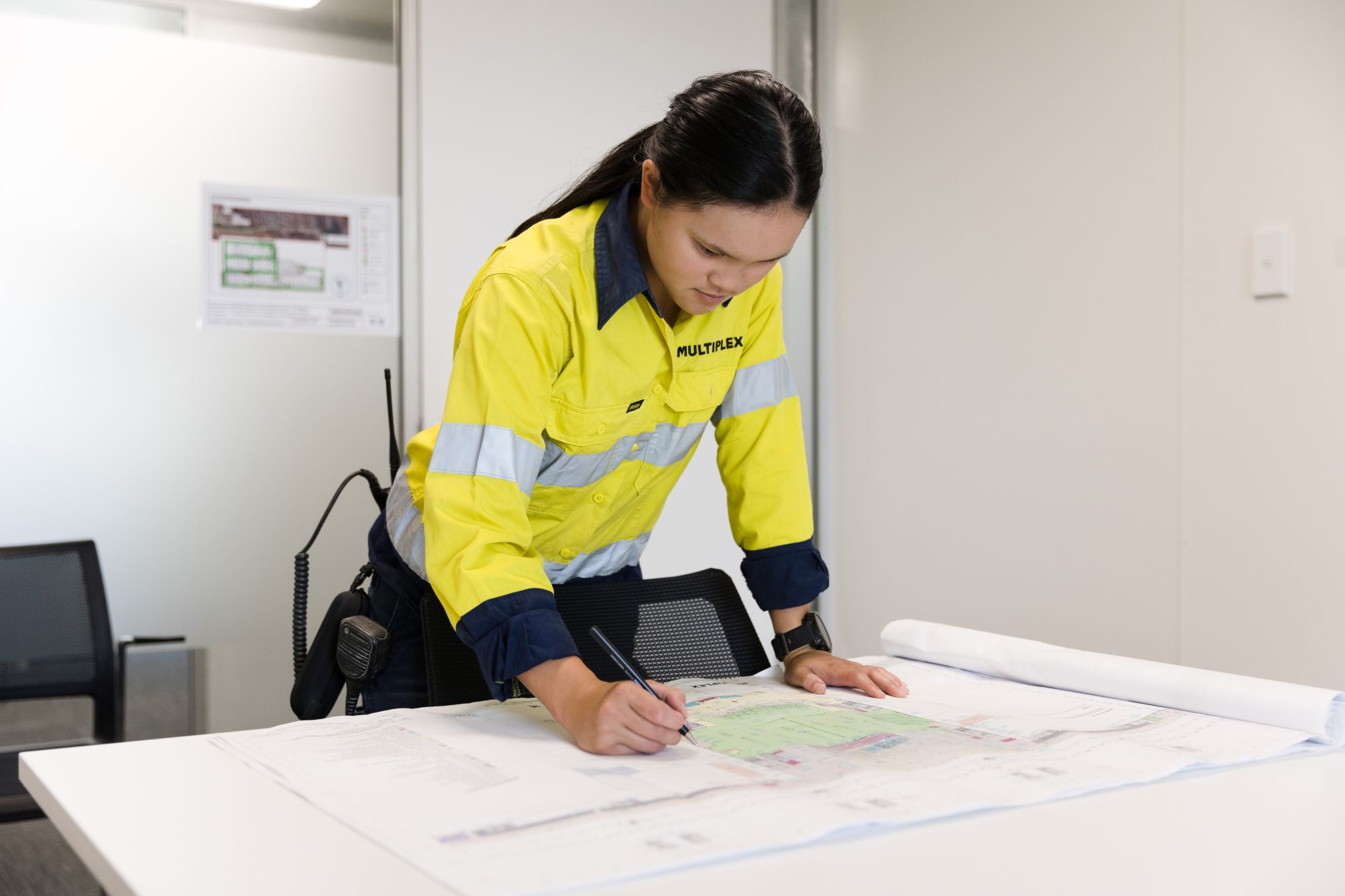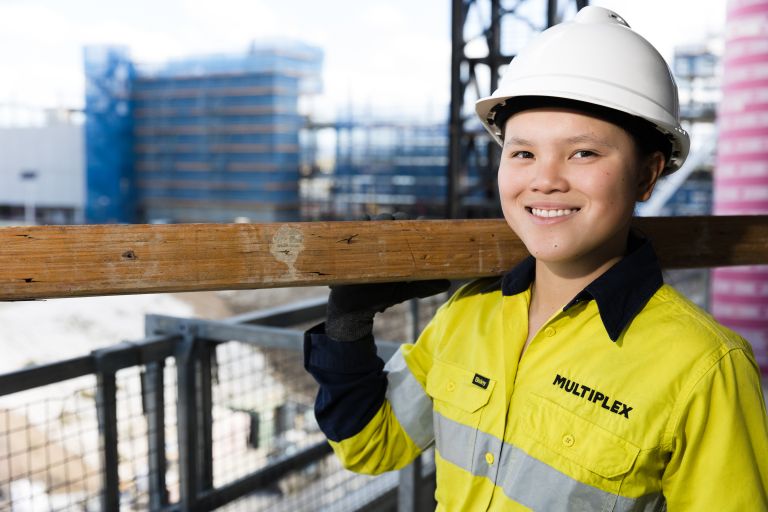About Kaitlyn
- Qualifications
- Favourite school subjects
- Childhood career plans
- What sparked your interest in a construction career?
I'm completing a Certificate III in Carpentry as part of my apprenticeship.
When I was in year 12, I completed half of Certificate II in Construction. Typically, it’s a course you take over both years 11 and 12. It gave me a head start on Certificate III in Construction because I got recognition for the competencies I’d achieved.
That meant I was able to spend less time in the classroom and more time on-site in the first year of my apprenticeship!
I successfully completed my Higher School Certificate 3 years ago.
To learn more about training and education opportunities, visit TAFE NSW.
In high school, my favourite subjects were Construction and PDHPE.
I’ve always been interested in rewarding jobs and serving the community. My dad's a doctor, and my mum owns a business. So, giving back to the community is important in our family.
At one stage, I wanted to be a police officer. Then, I wanted to be a high school teacher. I had a lot of influential teachers that helped me change my life for the better.
Eventually, I chose carpentry. It pays well, the work is enjoyable, and you can make good friends. And I’m giving back to the community.
I could never see myself doing a traditional female type of job. I wanted to do something different to contribute to my community and the wider world. I spent a lot of time outside when I was growing up.
I love being hands-on, and I think that sparked my interest in construction. Putting in the hard work and seeing the finished product, that’s fulfilment!
The turning point for me was finding my own carpentry work experience when I was at school. I really enjoyed it.
"Becoming construction trade qualified is setting me up well for my career. It doesn't matter if you go into residential or commercial carpentry, people are always going to want to invest, and there's always going to be plenty of work in carpentry."
Tell us about your current job?
The reason I chose carpentry is that I like to build. I enjoy seeing things through, from start to finish. The satisfaction I get from creating and building something, putting in the hard work and seeing it all come together is amazing.
I normally get to work around 6am in the morning for an official 6.30am start. Our pre-start meeting is at 6.45am where we go over safety and our list of tasks for the day.
We're on-site around 7am. I liaise with my site supervisor, we prioritise all our tasks, and then we get cracking. On any one day, I could be building a frame, putting up a door, jack-hammering, or something else. I'll have a break at 10am, lunch at one, and then knock off around 5pm.
There is flexibility around that though, so sometimes the team will knock off early or take time off for commitments outside of work.
I honestly think it's the people you meet along the way. I’m creating lifelong friendships. And the people I work with become like family.
I’m enjoying helping to build once-in-a-lifetime projects like the Western Sydney International Airport project where I am now. Previously, I worked on the Westmead Hospital and Quay Quarter Tower projects.
It’s amazing! I feel proud of what I’m doing.
The long hours and some days are physically demanding. When it's 35-degree heat, and I’m jack-hammering or doing one of those physically demanding jobs all day, that can be challenging. But the positives of the job outweigh the challenges.
I have a bit of an extroverted personality, and I think that helps in any challenge I face. That, and having an employer who looks after me.
I come across plenty of tradies, older ones, and they're used to their way of doing things. Sometimes, I’ll get asked if I want my job done for me. And I say, ‘No thanks, I’ve got everything under control’.
I haven't faced bullying or discrimination in the workplace, and I hope I never do.
In carpentry, we work in millimetres, so attention to detail is a vital attribute to have. Sometimes 1 to 2 millimetres is all the leeway you have.
So much of the carpentry we do, you cannot do by yourself. Standing up wall frames and putting up the roof can’t be done alone. So, you need to be able to work in a team and be able to communicate with suppliers and people from different trades.
There are always challenges in carpentry. So, we carpenters must be able to solve problems quickly. Time is money. Being able to remain calm, assess the problem and provide a workable solution is an important skill to have and develop.
Image

"Coming in as a first-year apprentice in a new workplace and not really knowing anyone, of course, I was a bit nervous, like anyone would be. But there are more and more women joining the trade nowadays. You’ve got to be able to be yourself, and it helps to be a bit brave. Don't be afraid to chat, share a joke and have a laugh."
Why did you choose to study Certificate II in Construction in high school?
I knew I wanted to become a carpenter and work in the construction industry, so studying Certificate II in Construction at high school was a perfect way to get an early start and build my construction career.
My parents and I wanted the best of both worlds for me: to get onto a construction site and get my HSC at school.
My parents and teachers helped me when I was deciding what I wanted to do. Carpentry is not a traditional pathway for girls and women to pursue, but it’s changing.
I was lucky that both my parents really supported me in choosing this role. They said if this is what you want to do and as long as you're happy, then we'll support you no matter what.
My teachers at school thought my choice was amazing. They said we needed more females going into trades and helped me to get into Certificate II in Construction and apply for apprenticeship jobs.
Certificate II in Construction has practical and theoretical components. It was a great experience in the lead-up to my construction apprenticeship.
The course has a strong focus on work, health and safety (WHS) to make sure you’re going to be safe on-site. We learned about the protective equipment used in construction and developed the skills and confidence to use hand and power tools. It also included doing my white card, which everyone needs for entry into any construction site.
We constructed mini wall frames, toolboxes, and basic tools for working in carpentry.
As I learned the knowledge and skills for each of the topics, I was assessed and marked as competent.
Our classes were held once a week from 2pm to 6pm at TAFE.
I’d 100% recommend Certificate II in Construction to other girls and women. It's essentially a taster course, a stepping-stone, to get you started in the construction trades industry. It provides basic knowledge and skills, so it’s helpful to anyone who is thinking about becoming a carpenter, plumber, or electrician.
The Certificate II in Construction course helped me to be a more confident first-year apprentice. On my first day as an apprentice, I was confident in my abilities. I felt that I wasn't going in under-prepared.
Because the Cert II and III courses have content that overlaps, I was able to get marked off as competent for the parts I’d already studied. That meant that as a new apprentice, I got extra weeks onsite which I liked.
Teachers help. So don't be shy! Figure out what you need to know and ask for their help.
To prepare for a good result in this course, you need to do extra work outside of class time. Schedule home study times into your calendar and stick to them. There are heaps of videos online that demonstrate the different construction and carpentry techniques in the course. Ask your teacher. I watched lots and found many of them helpful.
Be clear on the course requirements. For each subject in the course, there might be just an exam, or an exam and practical component. To be deemed competent and to get your certificate, you must pass everything.
Before you sit for a theory exam, your teacher will typically review the subject’s content with the class. Jot down the important points and update your notes. It will help you study and do better in the exam.
For the practical exams, everything you build has a specification or a ‘spec’. It’s a guide. Read it thoroughly and then build exactly to the requirements specified. Often, your teacher will set up mock practical exams so you can get some practice in – don’t miss them.
"Always put in 100% effort, even when you don't feel like it – in fact, that's exactly when you’ve really got to put in the hard work. Never give up!"
Why is the construction industry the best one to be in?
As an apprentice, you get paid to learn, which is awesome.
There’s the satisfaction of seeing your hard work in the end product – no matter which construction sector you are working in.
Work will always be available, whether it’s government sector infrastructure, commercial buildings, or residential work. Governments are always going to put money into developing hospitals and schools. The commercial sector is continually responding to the need for more retail outlets, offices, and hotels. And residential work isn’t going to stop. With communities expanding and people having babies, there’s always the need for more housing.
So, there's always work to be done throughout the construction industry, no matter what trade you are in.
And the lifestyle! Work starts early, and sometimes you finish early, which leaves time for family and hobbies and relaxing or whatever you like to do.
I chose carpentry because I like to build. I enjoy seeing things through, from start to finish.
The satisfaction I get from creating and building something, putting in the hard work and seeing it all come together is amazing.
I’ve always loved being outdoors. And carpentry is the best for that because you're always working outside. But then there are also days when you're inside. Carpentry gives you the balance of both.
There's always been at least one person on each work site willing to put in that extra time with me. Right now, I'm working under site manager Milos, and he's awesome. He has my best interests at heart, and I value his guidance, helping me to improve my skills so I can eventually get to where he is.
Don’t rush into making any career-related decision. And before you do, wherever you can, try it out. If you’re thinking carpentry, electrical or plumbing trades, try them out with a week’s work experience first. There are companies out there willing to take on work experience students for a week. Then, you’re more likely to know if it’s the right career pathway for you.
I was a top 3 finalist for the apprentice of the year in the 2022 Multiplex awards.
Image

What 3 things make a construction company a place where people want to work?
- Choose a happy company! Employee morale is so important. If you're in a work environment where people are happy, it makes all the difference.
- Look out for a company that offers a range of incentives to their employees. That’s everything from celebrations to bonuses and other incentives, like the safety reward system our company has started up.
- Align yourself with a company that does the work you’re skilled in. Some carpenters like big infrastructure high-end work, while others prefer smaller jobs in the residential sector.
What’s next careerwise? And, in the longer term?
I’m fortunate! Once I finish my apprenticeship, I can start preparing for site supervision-type roles on the pathway into management with my employer.
Eventually, I would like to be a site or construction manager or above.
I didn’t consider any other trade but carpentry. To be a good carpenter, you’ve got to be millimetre-perfect, and I'm a bit of a perfectionist. So, we fit well, and I’m good at it. And I think that's why carpentry has always also appealed to me.
It’s not essentially a trade, but I like cranes, and there are lots on my work site. So, I wouldn’t mind having a crack at being a crane operator, a dogman, or a rigger.
